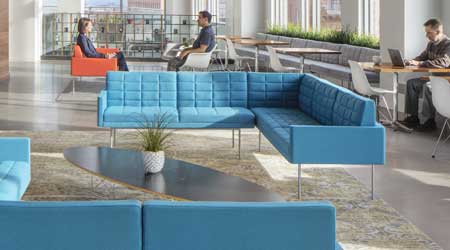 Darris Lee Harris
Darris Lee HarrisHow Corporate Culture Influences Workplace Design
Every company is unique. Here’s how companies are making their workplaces reflect who they are.
The day of the cookie-cutter workplace is over. There are companies for whom cubicles remain an efficient and effective solution to housing workers. But even the most traditional enterprises have discovered that the best workplace is one that reinforces the company’s culture. The workplace is one of the truest expressions of a brand — a living testament to company culture and values that impacts employees and customers alike, every day.
The single most common theme heard from facility managers? They want a workplace that aligns with the company’s culture.
This importance of brand-aligning space is even more crucial as the Baby Boom generation ages and younger workers, with different values and desires, enter the workplace amid fierce competition for workers.
When prospective employees — or customers — first walk in the door, will they see a soul-deadening array of monochromatic installations? Or will they find themselves in a space that bursts with the promise of collaboration, creativity, and thoughtful attention to their needs? Collaboration among all parties in the design process is the key to creating a workplace that announces: This is who we are.
Architecture and design are team activities in which the facility manager plays a critical role. The ideal process is one that reflects the dedication and sensibility of the facility manager as much as the contributions of the architect, designer, and engineer. The best design process also embraces input from employees. The people who staff your workplace have a good idea of what they need to do their jobs well — and what they’d like to work even better.
The design and layout of space can encourage the kind of cooperation that nurtures a culture where great things happen. And great culture is the secret sauce for a thriving company. Let’s look at how this simple idea can come to life.
One space, many uses
Digital Measures, a fast-growing software company based in Milwaukee that serves the higher-education market, had outgrown its space. Despite the desperate need for more room, leaving it behind was a tough decision. They had a great space they loved, which had served them well. Their challenge was to create a bigger, better space that retained the flavor of the place where they’d built their success.

(Digital Measures new office space is airy and light-filled, with floor to ceiling windows. An employee survey had showed that staff was interested in access to daylight and views. Photo credit: Darris Lee Harris)
An employee survey, commissioned with support from the C-suite, revealed that Digital Measures employees were interested in accessibility to daylight and views, better acoustics, a conference space large enough for community meetings, accommodations for staff members ranging from Generation Z to Baby Boomers, and a rooftop terrace with views of Milwaukee and Lake Michigan.
Their new space sits atop a historic building combined with a new addition in Milwaukee’s Third Ward, the city’s booming arts and fashion district. With an open floor plan, floor-to-ceiling windows, glass interior walls, and an atrium spanning two of its five floors, it’s airy and light-filled.
Yet within that space are many areas that serve different needs. All staff have access to small, private rooms — especially the sales staff, who tend to be the noisy ones.
There are a variety of conference rooms and touchdown spaces of varying sizes, as well as a large, open kitchen adjoining a collaborative work, meeting, and entertaining space. That also provides a space for the whole company to meet, which many organizations say is a must-have.
A connecting stair between two floors became a showplace branding feature: a “mug wall” displaying coffee mugs from each of the hundreds of client campuses Digital Measures visits. This feature creates a unique connection that highlights the company’s essential mission for every employee and visitor.
Employees also got their rooftop terrace, a feature that is increasingly in demand. Organizations really value the ability to connect with the outdoors.
Related Topics:















